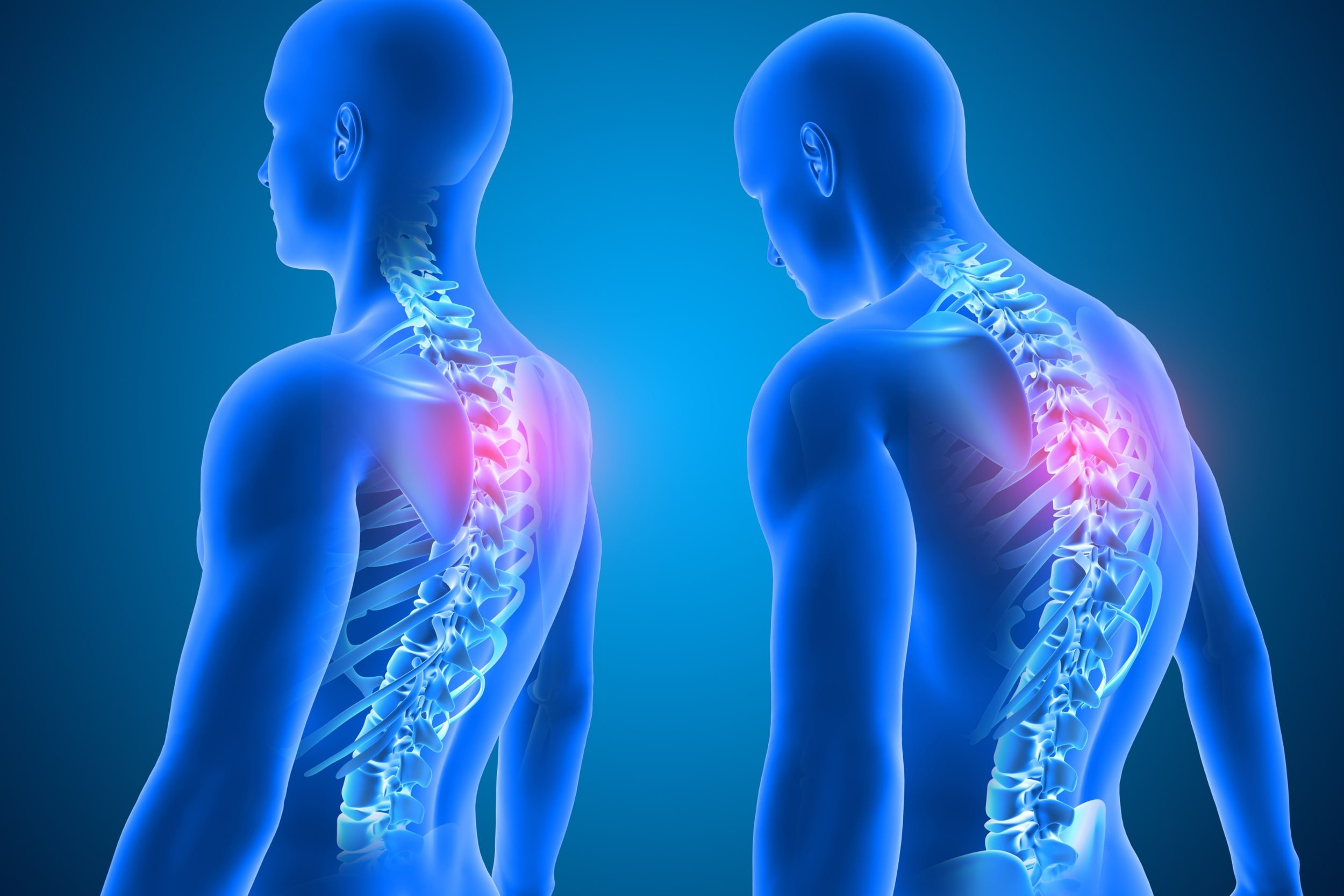
Upper Cross Syndrome
Start Improving Your Posture & Reduce Pain Today.
What is Upper Cross Syndrome?
Upper Cross Syndrome (UCS) is a postural disorder characterized by a specific pattern of muscle imbalances in the upper body. It occurs when the muscles of the chest and front of the neck become tight and overactive, while the muscles of the upper back and back of the neck become weak and underactive. This imbalance creates a characteristic "crossed" pattern, hence the name Upper Cross Syndrome. UCS is commonly seen in individuals who spend long hours sitting at a desk, working on a computer, or engaging in other activities that involve prolonged forward head posture.
What Causes Upper Cross SYNDROME?
The primary cause of Upper Cross Syndrome is poor posture, particularly forward head posture and rounded shoulders, which places excessive strain on the muscles and joints of the neck and upper back. This posture is often a result of:
Prolonged sitting at a desk or computer
Frequent use of smartphones or other handheld devices
Inadequate ergonomic workstation setup
Poor exercise habits or muscle imbalances
Lack of awareness about proper posture
Over time, these factors can lead to muscle imbalances and tightness in certain muscle groups, while others become weak and stretched, resulting in Upper Cross Syndrome.
What Does uPPER cROSS Syndrome Feel Like?
Upper Cross syndrome will typically have a few hallmark signs and symptoms although it can vary in severity among people for a variety of reasons. Individuals with Upper Cross Syndrome may experience a variety of symptoms, including:
Neck pain and stiffness
Headaches
Shoulder pain and tightness
Upper back pain and discomfort
Restricted range of motion in the neck and shoulders
Forward head posture and rounded shoulders
Fatigue and general discomfort in the upper body
If left untreated, Upper Cross Syndrome can lead to more severe issues, such as chronic pain, degenerative changes in the cervical spine, and reduced overall function and quality of life. It’s especially important to begin treating upper cross syndrome if you expect to be in a job or situations that are likely to cause it, for example, desk work or holding your children often.
What can Remedial massage do for upper cross syndrome?
Remedial Massage therapy can play a significant role in managing and treating Upper Cross Syndrome by addressing the underlying muscle imbalances that contribute to the condition. Some of the benefits of massage therapy for Upper Cross Syndrome include:
Reduced muscle tension: Massage can help relax tight muscles in the chest and neck, alleviating pain and discomfort associated with Upper Cross Syndrome.
Increased flexibility: By improving muscle length and elasticity, massage therapy can help increase the range of motion in the neck and shoulders, making it easier to maintain proper posture.
Improved posture: As muscle imbalances are addressed through massage, it becomes easier to maintain proper alignment in the upper body, reducing the strain on the neck and upper back.
Reduced pain and discomfort: Massage can help alleviate pain and discomfort associated with Upper Cross Syndrome by addressing muscle imbalances and promoting relaxation.
Enhanced overall well-being: By reducing pain and improving posture, massage therapy can contribute to an overall sense of well-being and improved quality of life for individuals with Upper Cross Syndrome.
In an ideal world, we would love to get rid of your pain and also help you improve your posture for good. We offer a complete posture assessment & know how to target the right spots, providing you better relief for longer.
How do we approach upper cross syndrome?
At CloudForm Massage, our skilled massage therapists are experienced in addressing the unique needs of individuals with Upper Cross Syndrome. They utilize a variety of massage techniques tailored to your specific requirements, such as:
Myofascial release: This technique focuses on releasing tension and restrictions within the fascia, the connective tissue that surrounds and supports the muscles. Myofascial release can help improve flexibility and reduce pain associated with tight muscles in the chest and neck.
Deep tissue massage: By applying deep pressure to the muscles and connective tissue, deep tissue massage can help break up adhesions and scar tissue, promoting relaxation and improved range of motion.
Trigger point therapy: This technique involves applying targeted pressure to specific "knots" or tight areas within the muscles, helping to release tension and alleviate pain.
Stretching and mobilization: Our massage therapists incorporate stretching and mobilization techniques to help improve flexibility and range of motion in the neck and shoulders, making it easier to maintain proper posture.
Swedish massage: This classic massage technique uses long, flowing strokes to promote relaxation and improve circulation, which can help alleviate pain and discomfort associated with Upper Cross Syndrome.
pERSONALISED Treatment Plans for uPPER cROSS sYNDROME Relief
At CloudForm Massage, we recognize that every individual's experience with Upper Cross Syndrome is unique, and a one-size-fits-all approach may not be effective for everyone. Our massage therapists work closely with clients to develop personalized treatment plans that address their specific needs and goals. This may involve a combination of massage techniques, as well as recommendations for self-care practices, such as stretches and exercises to help improve posture and muscle balance.
In addition to massage therapy, it is essential to address the lifestyle factors that contribute to Upper Cross Syndrome, such as ergonomics and daily habits. Our massage therapists can provide guidance and recommendations for making adjustments to your workstation, exercise routine, and daily activities to help prevent the recurrence of symptoms and promote long-term relief.
Why Choose Us to help you?
Read some of our amazing reviews by hundreds of beloved clients
Experienced, Professional, Therapeutic.
Supporting Your Journey to Improved Posture and Reduced Pain
At CloudForm Massage, our team is committed to helping you find relief from the pain and discomfort associated with Upper Cross Syndrome. Through the power of massage therapy, we aim to address the underlying muscle imbalances that contribute to this condition, providing you with the tools and support you need to improve your posture and enhance your overall well-being.
Don't let Upper Cross Syndrome continue to impact your quality of life. Discover the transformative benefits of massage therapy for managing Upper Cross Syndrome. Together, we can work towards a future of improved posture, reduced pain, and enhanced overall well-being.
Take the first step towards long term relief from Upper Cross Syndrome by scheduling an appointment with one of our skilled massage therapists at CloudForm Massage. Experience the benefits of a personalized treatment plan tailored to your unique needs, and begin your journey towards improved posture and reduced pain. Contact us today to book your consultation and start reclaiming your comfort and well-being.

Get relief for upper cross syndrome
FAQ About upper cross syndrome
What is Upper Cross Syndrome?
Upper Cross Syndrome is a common postural imbalance characterized by tightness in the chest and upper back muscles, coupled with weakness in the front and back neck muscles. This imbalance can lead to a forward head posture, rounded shoulders, and a hunched upper back, causing discomfort and pain.
What causes Upper Cross Syndrome?
Upper Cross Syndrome is often caused by prolonged periods of poor posture, such as sitting hunched over a desk or computer, using a smartphone, or engaging in activities that involve repetitive forward-leaning movements. These habits can lead to muscle imbalances, contributing to the development of Upper Cross Syndrome.
How can massage therapy help with Upper Cross Syndrome?
Massage therapy can help to alleviate the symptoms of Upper Cross Syndrome by targeting the tight muscles, releasing tension, and promoting relaxation. Additionally, massage can help to improve blood circulation, reduce inflammation, and enhance overall joint mobility, contributing to better posture and reduced pain.
How often should I receive massage therapy for Upper Cross Syndrome?
The frequency of massage therapy sessions for Upper Cross Syndrome will depend on the severity of your condition and your individual needs. Your massage therapist will work with you to develop a tailored treatment plan to address your specific concerns and help you achieve optimal results.
Are there any other treatments or lifestyle changes that can help with Upper Cross Syndrome?
In addition to massage therapy, incorporating stretching and strengthening exercises into your daily routine can help to correct muscle imbalances, improve posture, and reduce pain associated with Upper Cross Syndrome. Maintaining good posture, taking regular breaks from sitting, and using ergonomic equipment can also help to prevent the development or worsening of the condition.
Is massage therapy suitable for everyone with Upper Cross Syndrome?
Massage therapy is generally safe and beneficial for individuals with Upper Cross Syndrome. However, it is essential to consult with a healthcare professional before beginning any new treatment, especially if you have any underlying health conditions or concerns.
How long will it take to see improvements with massage therapy?
The timeline for improvement with massage therapy for Upper Cross Syndrome can vary depending on factors such as the severity of the condition, individual response to treatment, and adherence to a comprehensive treatment plan. Some individuals may notice improvements within a few sessions, while others may require more extended periods of consistent treatment to achieve lasting results.
Can Upper Cross Syndrome be completely cured with massage therapy?
While massage therapy can significantly alleviate the symptoms of Upper Cross Syndrome and improve overall posture, it may not completely "cure" the condition. A holistic approach, including regular massage therapy, targeted exercises, and lifestyle adjustments, can help to manage the symptoms effectively and prevent the condition from worsening or recurring.
What Else Can assist with upper cross syndrome?
Physiotherapy: A physiotherapist can provide personalized exercises and stretches to help strengthen weak muscles and improve posture, which can alleviate Upper Cross Syndrome symptoms.
Yoga: Practicing yoga can help improve posture, increase flexibility, and strengthen the muscles responsible for maintaining proper alignment, which can be beneficial for individuals with Upper Cross Syndrome.
Pilates: Like yoga, Pilates focuses on core strength, flexibility, and proper alignment, making it an excellent option for addressing muscle imbalances associated with Upper Cross Syndrome.
Ergonomic Assessments: Consider seeking an ergonomic assessment for your workspace or home office. An ergonomic professional can suggest adjustments to your chair, desk, and computer setup to promote better posture and reduce strain on your neck, shoulders, and upper back.
Mindfulness and Posture Awareness: Practice mindfulness techniques, such as deep breathing or meditation, to bring awareness to your posture throughout the day. Regularly check your alignment and make adjustments as needed to prevent muscle imbalances from worsening.
Heat and Cold Therapy: Applying heat or cold packs to the affected areas can help alleviate pain and inflammation associated with Upper Cross Syndrome. Heat therapy can help relax tight muscles, while cold therapy can reduce inflammation and numb pain.
Over-the-counter Pain Relievers: If necessary, use over-the-counter pain relievers such as ibuprofen or acetaminophen to help manage pain and inflammation. Always follow the recommended dosage guidelines and consult your healthcare provider if you have any concerns.
Regular Breaks and Movement: Take regular breaks from sitting and engage in light physical activity throughout the day. Incorporate stretching and strengthening exercises to counteract the effects of prolonged sitting and promote better posture.
Remember to consult your healthcare provider or massage therapist for personalized advice and recommendations tailored to your specific needs and circumstances.
Book With CloudForm Massage Today & Experience Our Difference.
We Look Forward to Seeing You!

